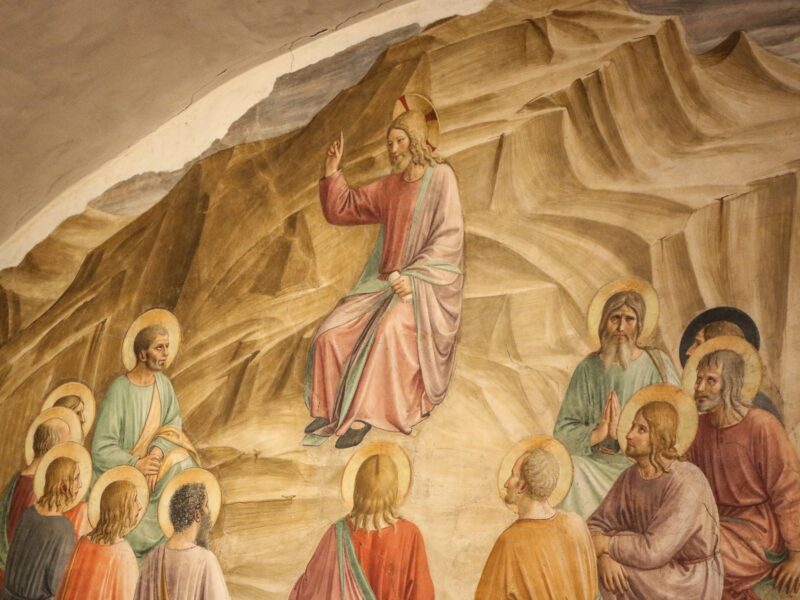
Full of Grace
Fourth Sunday of Advent. Fr Dominic Ryan ponders Our Lady’s unique closeness to Christ, the source of all grace.
Today’s Gospel directs our attention towards the Blessed Virgin Mary. In particular it directs our attention towards the fullness of grace that she received. That might surprise us somewhat given today marks the beginning of the fourth and – this year at least – rather abbreviated final week of Advent. We might have supposed that instead we would focus even more intensely on Christ. However, the choice is entirely appropriate. After all, Advent is a period during which we prepare to celebrate the solemnity of Christ’s Incarnation. Yet we won’t properly understand that incarnation unless we also understand Our Lady’s connection to it. Indeed, as it turns out, everything we say about the Blessed Virgin Mary in some way relates to and is verified by Christ and thus pertains to the mystery of the Incarnation.
An example will help illustrate the point. Think of a fire; the closer one approaches it, the warmer one gets, and the more of the fire’s heat one receives. Moreover the point generalises; the nearer one approaches any source or principle the more of its effect one participates in. Now let’s apply the principle to Christ. What is Christ the principle or source of? Well he became incarnate in order to overcome sin. He did so through his salvific death on the cross by which he merited grace for all people in all times and places. Christ is the source or principle of grace, therefore. As such the closer we are to that source the more of its effect we receive. However, the privilege of being the closest to that source of grace belongs exclusively to Blessed Virgin Mary and therefore it is the Blessed Virgin Mary who enjoys the fullness or perfection of grace.
Now two aspects of this perfection of grace are emphasised in the Gospel. The first occurs when the Angel Gabriel greets Our Lady and calls her ‘most highly favoured’. That an angel would show reverence to a human being is unheard of in the history of salvation. Elsewhere in sacred scripture when angels appear it is always a case of human beings showing reverence to them. That the reverse happens in the case of Our Lady should catch our attention. It’s significant. Yet of even more importance is what we can infer from this greeting. Namely that Our Lady is properly disposed – has been made worthy if you like – to become the mother of Christ. This could only happen through grace and, as Ineffabilis Deus teaches us, it happened from the first moment of her conception. From the very first moment of Our Lady’s conception she was preserved from the stain of original sin.
Impressive as this is, however, there is a second aspect of Our Lady’s perfection of grace which the Gospel directs our attention towards. We’re told she will ‘conceive and bear a son’. That son, of course, is Christ. But the crucial point here is that Our Lady will bear that son. She will be the God-bearer. Recall the point made earlier; the nearer one approaches a source or principle the more of its effect one participates in. One doesn’t get much closer to Christ than bearing him in one’s womb. Therefore in virtue of bearing Christ in her womb Our Lady’s perfection of grace is refined further. It turns out that not only is she free from the stain of original sin and properly disposed to be mother of God but also she is freed from the tendency to sin in virtue of the grace received as God-bearer.
Yet we should be careful not to understand Our Lady’s perfection of grace in merely negative terms. Grace makes a real difference to its possessor. Yes, Our Lady was free from original sin. Yes, she lacked the tendency to sin. But as well as this we can suppose she received the full quota of gifts that go with grace. Wisdom, the power of miracles, prophecy and more besides all belonged to Our Lady in virtue of her perfection of grace. She exercised those gifts in the manner proper to her during her earthly life and she does so now in the manner proper to her during her heavenly life. Indeed no saint has ever surpassed her in any of the virtues. Nor indeed could any saint have ever surpassed her. She was simply too close to the source of all grace, Jesus Christ her son.
Today then as we approach the end of Advent let us imitate Our mother Mary and allow ourselves to be as close to Christ as we can get.
Readings: 2 Samuel 7:1-5,8-12,14,16 | Romans 16:25-27 | Luke 1:26-38
Image: mural in the Co-Cathedral of St Joseph, Brooklyn, featuring the appearance of Our Lady to St Bernadette at Lourdes, photographed by Fr Lawrence Lew OP


